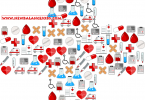The ability to punctuate correctly is the demand for good writing. Punctuation errors hinder the understanding of written material; hence, the need for writers to know the use of the most common punctuation marks, paying proper attention to problematic areas.
What is Punctuation?
Punctuation is a set of symbols and marks that aids clarity of meaning in a text by separating a series of words into clauses, phrases, and sentences.
SEE ALSO: Things to Consider while Writing a Retirement speech
Top 10 Basic Punctuation Signs and Symbols
1. Comma (,)
The comma indicates a separate part of a sentence or between elements or a list. It is used when the writer wishes to:
- Pause before moving on to the next phrase or sentence
- Add a phrase that does not include any new subject
- Separate items on a list
- Use more than one adjective to describe someone or something
For example,
- The girl, who knew that her uncle was about to arrive, ran quickly towards the opening door.
- She bought bottles of beer, fruit, vegetables, toilet rolls, cereals, and milk cartons.
- The boy was happy, eager, and full of anticipation at the start of his summer holiday.
2. Full Stop (.)
A full stop is used to indicate the end of a sentence. It emphasizes the end of an important point and that you are moving to further explanations or a related point.
Example:
- More people need to join BOA.
- The school is a private school.
- It is also used for marking an abbreviation.
- Example: etc., FAQ.
3. Exclamation Mark (!)
An exclamation mark is used to show excitement, surprise, or shock.
It denotes emotions within a sentence, such as fear, anger, or love. It is also used to show emphasis on the written, spoken word.
“Help! I love you!” Woah!
4. Question Mark (?)
The question mark always comes at the end of a sentence to indicate a question. It is used to express doubt and uncertainty.
Another name for the question mark is interrogation point.
For example:
- Are we at the end?
- When are we going?
- Why are you here?
- Are you sure?
5. Semi-Colon (;)
A semi-colon separates two clauses in a compound sentence. The clauses may contrast or support each other.
It is also used to separate items in a series (where commas are already in use).
For example,
- I can’t travel today; there’s a lot on my desk.
- The class was canceled today; Mr. Smith was homesick.
- Relatives at the reunion included my aunt, Kate; my nephew, Samuel; and my grandmother, Lucy.
SEE ALSO: Things You Need To Know Before Starting Your Copywriting Career Path
6. Colon (:)
The colon is commonly used to introduce a list or a quote. It is also used in front of a phrase or clause to expand the previous idea.
For example:
- He packed the following items into the basket: beer, fruit, vegetables, toilet rolls, cereals, and cartons of milk.
- The accident was fatal: Twenty persons, including the drivers of the vehicles, died.
7. Apostrophe (‘)
The apostrophe looks like a comma in shape. The difference between them is that the apostrophe is raised, and it performs a different function from the comma.
The apostrophe serves two main functions: To show possession and to indicate the omission of a letter(s)
For example,
- We’re going to do this course. (We are going to do this course.)
- I can’t do it. (I cannot do it.)
- The girl’s hat was green (girl is in the singular).
- This is Jane’s room
8. Quotation or Speech Marks (“….”)
Quotation marks are used at the beginning and end of a phrase to show that it is being written just like originally said or written.
For example,
- My grandpa said, “Share your chocolates with your friends.”
- “When are you going back to school?” she asked
- “Will you stop making a noise!” said Mrs. James
9. Hyphen (-)
The hyphen performs two major functions in written English: It is used to join words parts of a compound word or name. Examples: long-term, week-end, window-dressing
It is also used to split a word by syllables to fit on a line or at the end of a line.
Example:
- The sixteen-year-old girl is a full-time student.
10. Brackets ( )
Brackets are used to enclose additional explanation or comment about a word or a point that is not part of the main flow of a sentence.
The sentence will still be meaningful if the words between the brackets are removed.
For example:
- There was an old opinion (still commonly current) that a lunatic is a person suffering from a defect in their reasoning power.
SEE ALSO: Writing a Business Plan Cover Letter for Investors
Conclusion
Punctuation is a set of marks or symbols used in sentences, clauses, and phrases to clarify their meaning.
Some punctuation marks are the full stop (.), comma (,), question mark (?), exclamation point (!), colon (:), semi-colon (;), bracket (), hyphen (-), and quotation mark (“…..”).






